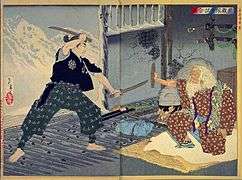Tsukahara Bokuden
Tsukahara Bokuden (塚原 卜伝, 1489 – March 6, 1571) was a famous swordsman of the early Sengoku period. He was described as a kensei (sword saint). He was the founder of a new Kashima style of kenjutsu, and served as an instructor of Shōgun Ashikaga Yoshiteru and Ise provincial governor daimyō Kitabatake Tomonori.[1]

Early life
Bokuden was born into the Yoshikawa family within the Hitachi Province of Honshu. The family was one of four Karō families serving the Kashima clan; one of the cadet branches of the Imperial House of Japan (descendants of the Imperial Prince Kazurahara (葛原親王, 786–853)). Bokuden was adopted by the Tsukahara family, an offshoot of the Kashima clan; he was styled as Tsukahara Bokuden Takamoto. Earlier in his life, his name was Tsukahara Shin'emon Takamoto.
Career
Bokuden learned the Tenshin Shōden Katori Shintō-ryū from his adopted father and later honed his skills by engaging in musha shugyō (warrior's ascetic training), traveling throughout Japan and training with most of the skillful and knowledgeable swordsmen of the day. Tsukahara Bokuden was the classic knight-errant; a rich nobleman, he travelled the Japanese countryside, often with a full entourage. He later systematized the teaching of the Kashima area's local martial arts, including such approaches to combat as Kashima no tachi and Ichi no tachi. After allegedly receiving a divine inspiration from Takemikazuchi no kami, the deity of Kashima Shrine, he named his martial system as Kashima Shintō-ryū. He also, for a brief period, called his system Mutekatsu-ryū ("winning without hands").
A famous Japanese folk tale tells of the young Miyamoto Musashi challenging Bokuden to a duel during a meal. When Musashi struck first, Bokuden parried the sword with the lid of the iron pot he was eating from. In reality the story has no basis in fact—Bokuden had died 13 years before Musashi was born.
According to Tokitsu Kenji, Tsukahara fought his first duel to the death at the age of 17 and won. Then, he duelled again 19 times and fought in 37 battles. He was wounded 6 times in total, but only by arrows. In total, his death toll seems to have reached 212.
Death and legacy
Bokuden died of natural causes in 1571. His grave at Temple Baiko of Suga (須賀の梅香寺) is in Kashima, Ibaraki. Those devoted to the art of Japanese sword-fighting, would make pilgrimages to the Kashima Shrine because it is considered the spiritual home of kenjutsu.
References
Bibliography
- Steven Turnbull: The Samurai Swordsman. Tuttle Publishing 2008, ISBN 4-8053-0956-3 (restricted online version (google books))
- Jinichi Tokeshi: Kendo: Elements, Rules and Philosophy. University of Hawaii Press 2003, ISBN 0-8248-2598-5
- Tsukahara Bokuden: The Hundred Rules of War. Createspace Independent Publishing Platform 2017, ISBN 9781548035662